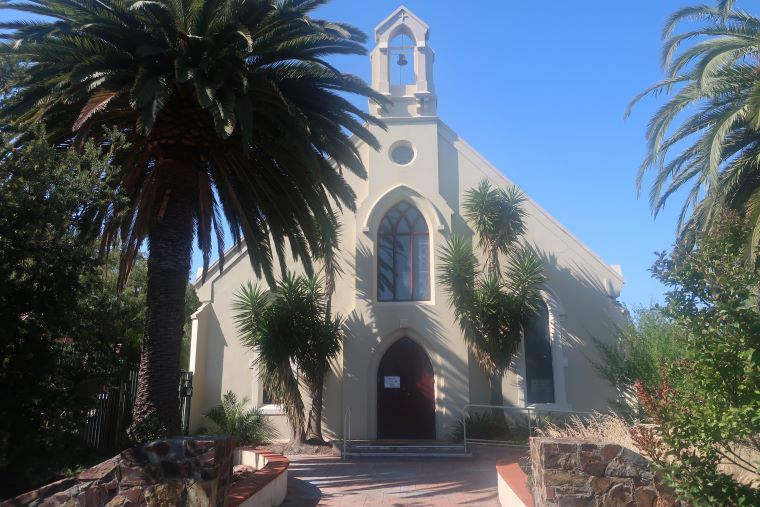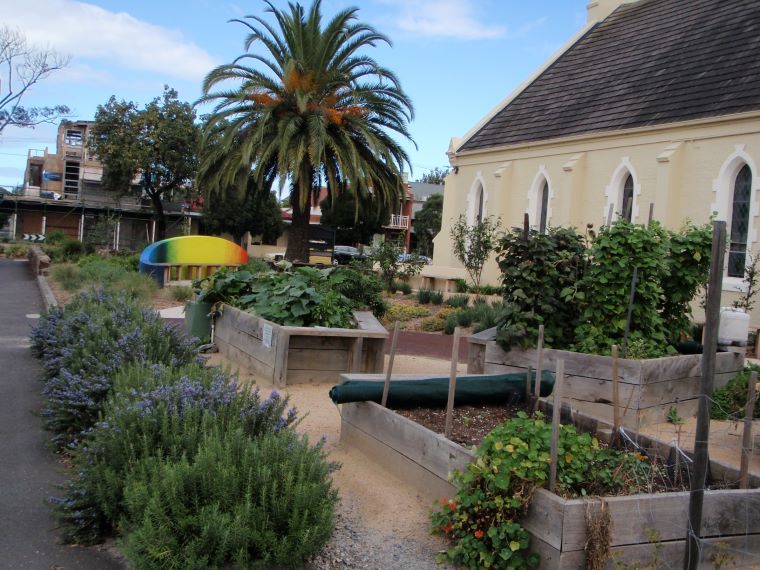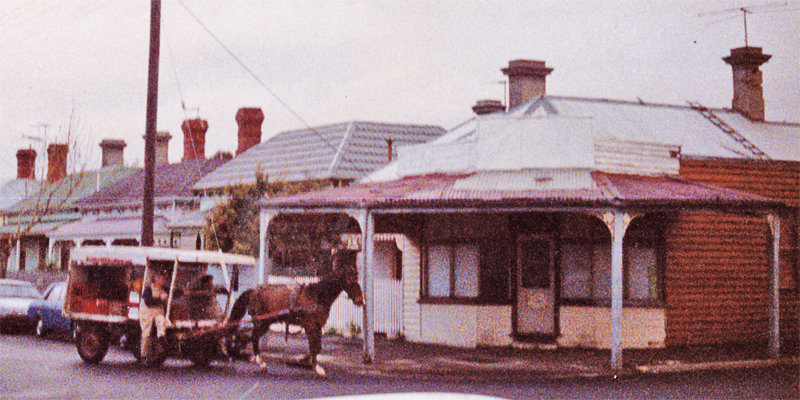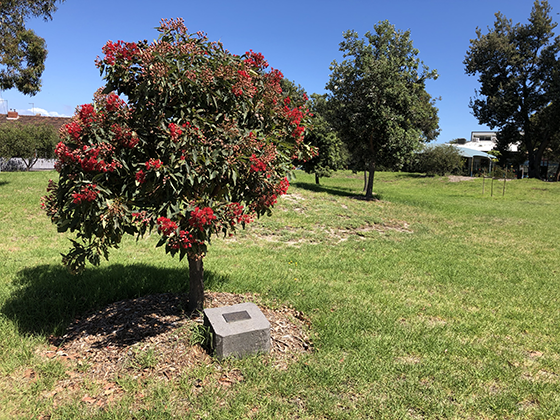Port Melbourne Uniting Church 1864 – 2022
The Rev. John Tansey conducted the final service of he Port Melbourne Uniting Church congregation at 5 pm on Sunday, November 2022. Anne Garrow, a member of the congregation since 1984, gave this overview of the Church’s history
Before this church was built, this land was occupied by the Yulukit Wilam clan of the Boonwurrung people. The early paintings of Wilbraham Liardet show the wooded landscape and Aboriginal people with their fishing catch. They help us to imagine how the area, with the river and sea and lagoons and wooded land, would have been abundant country.
I acknowledge the traditional owners of this land and that the land was never ceded.
The history of the church on this site has been dynamic. It has been shaped by demographics and social forces, by debates about convention and progress, by denominations and unification, by personalities and pragmatics and by viability and finances.
In the 1850s, the Presbyterians were not a united group and it was the Free Church Presbyterians who called the first minister to the Sandridge area. By the time the funds were raised to build this church a new minister, Dr Donald McDonald, had arrived and he helped to instigate the Union of Presbyterian churches.
In 1863 a Foundation Stone was laid with much fanfare which included placing a bottle in the cavity beneath the stone and in which was included the names of the church committee, the architect, a copy of the Argus and some coins.
“The Sandridge Marine Lodge performed the masonic ceremony of laying of the stone. The lodge was joined in a procession by the Ancient Order of Foresters and the United Order of Oddfellows. The Immigrants Fife and Drum band led the procession and the Chairman and Members of the newly appointed Sandridge Municipal Council were present … The Choir sang a psalm as the stone was lowered.”1
There was a housing boom west of the railway in the 1880s and with it came an expectation that this would translate into increased membership. This did not occur. The expectation of the congregation increasing with new housing developments is a recurrent theme. In recent decades we imagined that first Beacon Cove and then the general increase in inner urban population density would translate into new members. This has not been the case.
Over Rev. Abernathy’s years the congregation numbers were around 100 to 150. The early 20th century did see an increase in membership, peaking at 186. By 1914 the church was debt free and was able to install electricity and a metal ceiling. The writer of the Centenary of the church in 1964 called this period “the golden age.”
After the First World War the numbers fell again. By 1920 membership was below 100 and the Church Board spent much time considering what to do. Abandoning the practice of pew renting was considered but rejected. While church attendance was down, the Sunday school was flourishing with over 100 children and a new kindergarten hall and kitchen were built in 1925. This became a day kinder in 1946. A bequest enabled the installation of a pipe organ in 1925, the same year that the baptisimal font was dedicated. In 1937 a new vestry room and committee room were erected with the support of the estate of a congregation member.
The Second World War years saw an invigoration of church life with American troops who were stationed nearby on Murphy’s Reserve attending the church and using the buildings as a writing room. After the war, in the 1950s and 1960s there was a continuing drift to the suburbs of people who had been church members and new residents coming in to the area were not joining. The church was struggling financially and in 1963 it became a home mission meaning it could not finance a full time minister. A theological student was appointed.
In 1965 the Port Melbourne Methodists and Presbyterians started worshipping together at this church. The bluestone Methodist church in Graham St had opened in 1861 but by 1965 it required extensive repair and was “in dire straits financially.”2 The Farrell Street Methodist church had closed two years earlier.
At this time, as part of the plan to create a financially viable amalgamated church for the united Methodists and Presbyterians, the manse next to Bridge St church was demolished and 36 flats were built with the plan that the lease would pay for the minister and church expenses. By 1986 this model was no longer viable and the lease on Abernathy Court was sold to clear indebtedness.
In 1971 a regional parish was formed. This included the Methodist and Presbyterian churches in South and Port Melbourne and Albert and Middle Parks. It was part of a vision for renewal and revitalisation and this regional united church preceded the formation of the Uniting Church of Australia by 6 years.
While the Port Melbourne church was now part of a regional church, meaning that one church council oversaw much of the administration and direction of the Parish, the Port Melbourne congregation maintained its independence in matters relating to worship and congregational life and local mission activities.
In the early 1990s white ants were found to be eating away the stumps and flooring. The repair works included levelling the sloped floor, removing the screen that formed a foyer area and not replacing fixed pews thus creating a more open and flexible space. This suited a new form of music with the piano and guitars becoming the accompanying instruments after the death in 1995 of Erica Wilson who had faithfully played the organ for decades. Allan Hoare, a musician (guitar) and song writer, has led the music over the past two decades accompanied more recently by his son Simon.
During this period the Port Melbourne Salvation Army in Spring Street closed its doors and a number of members joined the congregation. It was also in the 1990s that joint services were held in the church with Holy Trinity Anglican Church. Ultimately personality differences prevented a united congregation forming.
The Reverend Peter Greenwood arrived in 2000. A former architect, he could see the potential of re-orienting the worship space with the congregation sitting in comfortable chairs and a re-orientation so that the focus of the congregation was toward the table and lectern on western side.
In the early 2000s the congregation committed to taking action and engaging in issues around environmental sustainability in an inner urban community. This resulted in the development of an open community garden in 2008 on what was previously a vacant and bare block of land. Since that time the garden has become a major point of engagement with the community.
In 2022 an Eritrean congregation began worshipping in the church on Saturdays and it is likely that in the future the Korean So Mang congregation, which is affiliated with the Uniting Church, will use the church on Sundays.
Looking back over the 158 years since the church was opened one can see the evolving responses to the changing community in which the church is located. Changing demographics have impacted on church membership and ways the congregation has sought to engage in outreach in the community. The building has been modified internally to suit the changing times and consolidaiton and amalgamation have been an ever present theme. From the Free Presbyterians, to the Union of Presbyterians, to a united Methodist and Presbyterian church in Port Melbourne, to the formation of the Uniting Church, and now today, the formation of a new regional Uniting Church.
References
1 Port Melbourne Presbyterian Church. Centenary Souvenir. An Historical Sketch 1864 – 1964. (1964) Printed by Riall Brothers, 282 Bay Street, Port Melbourne
2 Breward, Ian (2003) South Port Parks Parish Mission – 150 Years of Service.
See also The Church at 170 Farrell St





2 Comments
Glen Cosham
Anne,
I think the reference to American troops being stationed nearby at Murphy’s Reserve is incorrect. They were at Port Melbourne Cricket Ground.
Glen
P
i agree with Glen
also, love this story